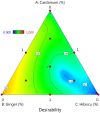Application of mixture design methodology for development of high antioxidant fruity functional beverage
- PMID: 35844924
- PMCID: PMC9281929
- DOI: 10.1002/fsn3.2834
Application of mixture design methodology for development of high antioxidant fruity functional beverage
Abstract
Three red color fruit juice (pomegranate (PJ), barberry (BJ), and grape juice (GJ)) and three plant extracts (cardamom essential oil (CE), ginger extract (GE), and hibiscus solution (HS)) were used for the development of different functional beverages. Organoleptic analysis was done to detect the most acceptable fruit juice blend. The physicochemical properties of the samples including total phenols, 1,1-diphenyl-2-picrylhydrazyl (DPPH) inhibition percent, anthocyanin, flavonoid, and vitamin C content of optimum fruit juice blend (60% PJ/20% BJ/20% GJ) were 121.57 µg gallic acid equivalent (GAE)/ml, 80.28%, 4.03 mg/L, 64.87 mg/100 ml, and 51.10 mg/100 ml, respectively. To determine the optimum level of extracts and essential oil (GE, CE, and HS) in fruit juice blends, the mixture design method was used and 14 runs (formulations) were obtained. In all formulations, samples containing HS had the highest content of antioxidant and active components and the statistical analysis indicated that the sample containing 0.5 CE/0.5 GE/1 HS (ml/100 ml) had the optimum content of antioxidant components. Thus, the results of this study introduce a functional drink possessing high polyphenols, antioxidants, anthocyanin, and vitamin C content.
Keywords: essential oil; extract; functional beverage; mixture design; optimization.
© 2022 The Authors. Food Science & Nutrition published by Wiley Periodicals LLC.
Conflict of interest statement
We wish to confirm that there are no known conflicts of interest associated with this publication and there has been no significant financial support for this work that could have influenced its outcome.
Figures



References
-
- Ademosun, M. T. , Olufunmilayo, S. O. , & Aderonke, I. O. (2020). Antioxidant properties, glycemic indices, and carbohydrate hydrolyzing enzymes activities of formulated ginger‐based fruit drinks. Journal of Food Biochemistry, 45, e13324. - PubMed
-
- Adesokan, I. A. , Abiola, O. P. , Adigun, M. O. , & Anifowose, O. A. (2013). Analysis of quality attributes of Hibiscus sabdariffa (zobo) drinks blended with aqueous extract of ginger and garlic. African Journal of Food Science, 7(7), 174–177.
-
- Amma, K. , Rani, M. , Sasidharan, I. , & Nisha, V. (2010). Chemical composition, flavonoid‐phenolic contents and radical scavenging activity of four major varieties of cardamom. International Journal of Biological and Medical Research, 1(3), 20–24.
-
- Berenji, S. , & Akhavan, H. (2018). Effects of gamma irradiation on chemical and antioxidant properties of Iranian native fresh barberry fruit. International Journal of Nutrition and Food Engineering, 12(9), 304–307.
LinkOut - more resources
Full Text Sources

